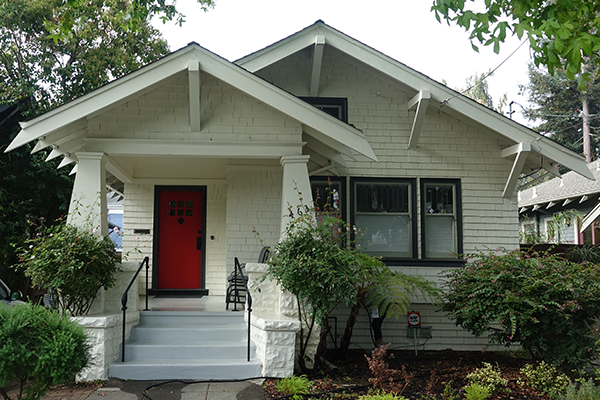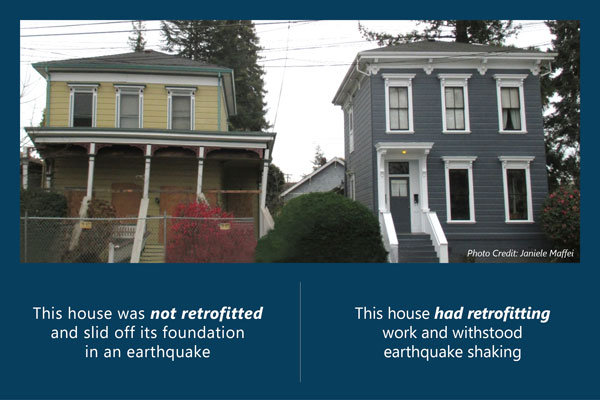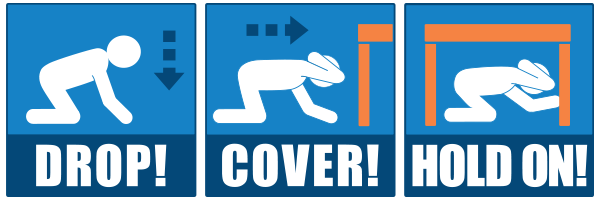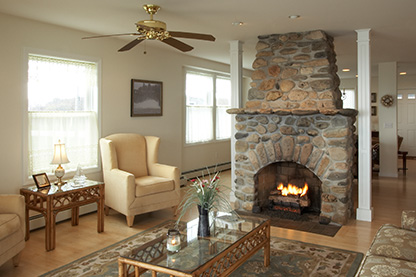Every region of our state faces a significant earthquake risk, which is why earthquake preparedness in California is so important. The Golden State is home to nearly 16,000 known earthquake faults, and more are continuously being discovered. This guide explains how to help prepare your home and your family for a major earthquake, how to mitigate your risk of property damage, personal injury, and financial loss.
- California Office of Emergency Services MyHazards can help you find out if the area where you live or work is prone to earthquake-induced landslides.
- Discover where the active faults are in your area.
- Learn about your house’s structural risks and the steps you can take to seismically strengthen your house.
How to Prepare for an Earthquake
Earthquake preparedness starts long before an earthquake occurs. Protecting your family members, pets, and your home during an earthquake requires advanced planning, and the best time to begin your preparation is now. Create your own earthquake preparedness plan by following these five simple pieces of advice.
- Identify the active earthquake faults in your area to assess your overall earthquake risk.
- Learn about your own home’s structural risks and find out how to strengthen your home against earthquake damage.
- Visit the California Office of Emergency Services MyHazards website to find out if the area where you live, or work, is prone to earthquake-induced landslides, tsunamis, and other disasters.
- Read about What to do Before, During and After an Earthquake so that you are better prepared to handle the unique challenges posed by earthquakes.
- Follow these Seven Steps to Earthquake Safety to help you become better prepared against the threat of a major earthquake.
Identify Active Faults in Your Area
Despite its natural beauty, the Golden State is not without its faults with 15,700 known earthquake faults, more than 500 of which are active. Most California residents live within 30 miles of one of these active faults. So, it is important to understand your area’s earthquake risk and the related hazards in your community.
Learn About Your House’s Structural Risks
While earthquakes in California are inevitable, the extent of the damage they cause is preventable. This is where earthquake preparedness at home comes in. Many older houses in the Golden State are vulnerable to the strong shaking caused by earthquakes because they were built before modern, statewide seismic building codes were put in place.
Each house may have different structural risks, based on its style of construction. It’s important to understand the type of risk your house has, how to identify it, and learn what you can do to help strengthen your property against earthquake damage. Below are some different types of homes - learn more on the steps you can take to strengthen them.
- Raised Foundation homes usually are older homes with steps up to the first floor, which can shift off their foundations from shaking. They can be strengthened by bolting or bracing and bolting the house to its foundation. These types of vulnerable homes typically were built prior to 1980, before modern building codes were put in place.
- Living Space Over Garage homes have one or more floors of living space over an attached garage and are vulnerable to shaking. Retrofitting the garage space can help make these homes more resistant to earthquake shaking.
- Post & Pier homes are without a continuous, concrete, perimeter foundation and can potentially shift or collapse in an earthquake. Adding a foundation that is braced and bolted can help strengthen the house.
- Hillside homes are literally built on hillsides or slopes, resulting in the need to be strengthened in several ways to be properly braced against earthquakes. Most hillside house require an engineered retrofit. As such, owners of these type homes are advised to hire a licensed structural or civil engineer to inspect the house and come up with a specific retrofitting plan.
- Mobilehomes and Manufactured homes can slide off their support systems during an earthquake. These homes can be strengthened against shaking with a seismic bracing system.
Visit the MyHazards Website to Assess Your Landslide Damage
Earthquakes can produce a real risk of landslides, which are a downward sliding of dry earth either from cliffs or mountains. Protecting your property against potential landslide damage often is overlooked even though it can cause a great deal of damage. The 1994 magnitude 6.7 Northridge earthquake resulted in more than 11,000 landslides, according to the United States Geological Survey.
An earthquake hazards tool, such as this one on the California Office of Emergency Services website, provides seismic hazards mapping information to help you become more familiar with earthquake hazards, including landslides, in the specific area in which you live.
Find Out What to Do Before, During and After an Earthquake
Being prepared for the next major earthquake is mostly about having a plan for what needs to happen before, during and after an earthquake. An earthquake preparedness plan that is familiar to you and members of your family can help reduce anxiety and confusion. Earthquake preparation can also lead to better decision making at a time when you and your loved ones’ lives may be at risk. It is extremely important that your entire family is familiar with your earthquake preparedness plan so that everyone knows exactly what to do when the next big one strikes.
Follow the Seven Steps to Earthquake Safety
You can help decrease your risk of damage and injury from an earthquake by reading and practicing the Seven Steps to Earthquake Safety. These earthquake preparedness tips were developed by the California Earthquake Authority and the Earthquake Country Alliance and are designed to help you become better prepared for a major seismic event. When it comes to earthquake preparedness at home, make sure to review these steps with every member of your household so that everyone is better prepared to face the serious threat of a large earthquake.
Step 1: Secure Your Space
It’s important that you take steps to make sure your home is prepared for an earthquake. You can help reduce your risk of personal injury and property damage by identifying potential hazards. Here are some tips:
- Move large, heavy household items away from doors.
- Check the flexibility and sturdiness of flexible connections where gas lines and appliances meet.
- Beds need to be moved away from windows.
- Overhead fixtures, such as lights, need to be braced.
- Studs should be used to secure heavy furniture.
- Use metal straps attached to studs to brace and protect water heaters.
Step 2: Plan to be Safe
Communication is an important element when it comes to emergency preparedness. Remember that not all family members may be home when an earthquake occurs. Keep in mind that text messages may work better than phone calls during and after an earthquake. Here are some earthquake preparedness tips to consider as you develop your family plan:
- Make sure all emergency contact information is entered into the cell phones of all family members.
- Practice your family’s earthquake preparedness plan with all family members.
- Keep the plan in a designated common area - maybe attach it to your refrigerator - and keep copies in cars, briefcases, handbags, and backpacks.
- Gather contact information about your family and their doctors, schools, and workplaces. Include information on out-of-town relatives and close friends and be sure all family members know where emergency supplies are located.
- Have all family members sign up for the ShakeAlert app at www.shakealert.org.
Step 3: Organize Disaster Supplies
The American Red Cross advises that you have an emergency safety kit readily available and accessible. It should ideally include at least a three days’ supply of food and water for each member of your household and your pets. The kit should also include the following:
- Cell phone with chargers and backup battery
- Flashlights, portable radios, and batteries
- First aid kit and medications
- A whistle to signal for help if necessary
- Moist towelettes, garbage bags and plastic ties
- Manual can opener, wrench or pliers and a dust mask
Step 4: Minimize Financial Hardship
Being able to access personal and financial documents after an earthquake is a critically important preparedness step. Whether it’s storing such documents in a fireproof bag, on a portable drive kept in your emergency kit or in the Cloud, this should be at or near the top of your list. Consider including the following documents in an accessible and protected emergency kit:
- Checking, savings, debit card information along with retirement and insurance documents
- Housing ownership documents, such as mortgage documents and home titles, home, auto and earthquake insurance policies, lease, and rental contracts
- Utility bills, credit card information, list of valuable property, safe deposit box keys
- Tax statements and wills, trusts and other estate planning documents
Step 5: Drop, Cover, and Hold On
Protecting your safety and your family’s safety are the most important things to do when an earthquake strikes. The following safety steps are strongly recommended:
- Immediately drop to the ground and get as far away as possible from heavy furniture that could fall or windows that could shatter.
- Cover yourself by crawling under a heavy desk, table, or other piece of furniture. If there is no nearby heavy furniture to crawl under, cover your head and face with your arms, find an inside corner of the building or structure you are in and get in a crouch position.
- Hold On and stay in place where you are until the shaking stops. When it comes to earthquakes, research has shown that most injuries occur when people inside buildings and structures try to leave or move to another location.
Step 6: Improve Safety
There are many earthquake preparedness tips that you can take to protect yourself, your family, and your home. For example, if you live in a home built before 1980, it may need a seismic retrofit to make it more resistant to earthquake damage. When it comes to these older homes, it is a good idea to include on your earthquake preparedness checklist an inspection of your home’s structure. Once the earthquake shaking has stopped, check yourself and others for injuries, inspect your home and surroundings for damage and follow these additional suggestions:
- Be careful around broken glass and debris.
- Call 911 for seriously injured people.
- Listen to the radio for important information and instructions.
- Do not enter damaged buildings and areas.
- If you smell gas, open all the windows and doors, leave immediately, and report the leak to the authorities.
It is wise to seriously consider a seismic retrofit. This is a major step that can help to prevent shake damage. Learn more about the benefits of seismic retrofitting.
Step 7: Reconnect and Restore
It’s important to not lose sight of your preparedness plan after the earthquake occurs. It’s likely that aftershocks may continue for several days and cause additional damage. Always remember to Drop, Cover and Hold On when the ground starts shaking. When the shaking stops, it is the time to begin reconnecting with others, repairing damage, and attempting to return to some form of normalcy. Consider the following steps as the reconnect and restore phase begins:
- Text your out-of-area relatives, friends, and other contacts to bring them up to date on your status.
- Stay off the phone when it comes to landline phone calls and cell phone calls as those lines need to be kept clear for emergency responders.
- Reach out to your local community organizations and check on your neighbors.
- If you have earthquake insurance and if your home has sustained damage, contact your insurance company to file a claim.
- If you need to repair your home, always use a state licensed contractor, and try and obtain at least three bids. The Contractors State License Board is a good source regarding licensed contractors.
What Else Can I Do to Prepare for an Earthquake?
In addition to the Seven Steps, another important way to prepare for an earthquake is to gain a better understanding of your home’s earthquake’s resistance. Schedule a visit with a licensed contractor or structural engineer to learn if the structural elements of your home need reinforcing. Common retrofits include:
- Adding anchor bolts or steel plates between your home and its foundation.
- Reinforcing the inside of your home’s crawl space wall (cripple wall), the short wood-stud wall between the top of the foundation wall and the first floor.
- Bracing unreinforced chimneys, masonry and concrete walls and foundations.
Understand Structure and Geologic Threats to Your Home
Earthquakes can rupture the earth, trigger landslides, and turn the surface of the earth to liquid. If your home was built before 1980, it may be vulnerable to serious structural damage from a quake’s violent shaking.
Preparing for an earthquake includes understanding your home’s structural threats. A seismic retrofit involves strengthening your home to make it more resistant to earthquake shaking. Some structural threats can be lessened with the help of a California licensed engineer with seismic experience.
Reinforce Your House
California earthquakes can’t be prevented, but you can prepare for them. Older homes are especially vulnerable to earthquake damage. If your house was built before 1980, the best way to prepare for an earthquake and prevent serious damage is with a seismic retrofit to create a stronger connection to the house’s foundation.
Improving the connection between the wood-frame and the concrete foundation of a house can help to reduce major structural damage during an earthquake.
If your house has a chimney and fireplace, those should be evaluated as well. Chimneys and fireplaces with masonry veneer and decorative surrounds can crumble and collapse during an earthquake, causing death or injury to those nearby, and can cause damage to your home. Learn more about the ways to strengthen those other house hazards.
Strengthen Your House with an Earthquake Retrofit
Start your earthquake safety preparedness today before the next big California earthquake. Begin by considering if your home needs to be strengthened to help reduce the likelihood of earthquake damage.
An earthquake causes the ground under the house to shake and shudder, but gravity tries to hold the structure in place. This torquing of the structure causes weak sections of a house to break. Weak foundation-to-frame connections tend to face damage along entire sections of a home.
Take the next steps. Find out what kind of earthquake retrofit your house may need. Make your house stronger and your family safer today.
Earthquake Preparedness Frequently Asked Questions
A. Earthquake preparedness is a way for you and your family to be ready when the next big earthquake strikes. Preparedness starts by taking steps to ensure the safety of your family members, pets, and home before the earthquake occurs. The best time to begin your planning and preparation is now. A good, proactive first step is to learn more about retrofitting and then to strongly consider whether a seismic retrofit will help make your home more resistant to earthquake damage.
A. Being prepared for an earthquake is important because it can help protect the safety of you and your family when a major earthquake strikes. Earthquake preparedness can mitigate your risk of property damage, personal injury, and financial loss.
A. The Seven Steps to earthquake safety are: Secure Your Space; Plan To Be Safe; Organize Disaster Supplies; Minimize Financial Hardship; Drop, Cover and Hold On; Improve Safety; and Reconnect and Restore. When it comes to earthquake safety preparedness, it’s important to add these important steps at or near the top of your earthquake preparedness checklist.
A. Before an earthquake occurs, you should have your earthquake preparedness plan in place for what needs to happen before, during, and after the shaker. Having a preparedness plan that is familiar to you and members of your family is an important step. During and after an earthquake, you can decrease your risk of damage and injury by practicing the Seven Steps to Earthquake Safety.
A. Research has shown that most injuries occur when people inside houses or buildings attempt to move to a different building location or try to leave their home or building. If you are inside a home or building, stay inside and in place until the shaking stops. If you are in your car and driving during an earthquake, pull over to the side of the road and stay inside your car until the shaking stops. No matter where you are during an earthquake, remember to Drop, Cover, and Hold On.
A. The incredibly strong shaking of the ground is what makes earthquakes so dangerous. The strong shaking causes homes, buildings, roads, bridges, and other infrastructure to collapse. It can also result in injuries and deaths. In addition, other damage caused by earthquakes can include ground rupture, landslides, tsunamis, and liquefaction. The damaging shaking of major earthquakes can be felt hundreds of miles away. When it comes to your personal property, one way to reduce the damage of earthquake shaking is to determine if your own home could benefit from a seismic retrofit.
A. Simply put, there are three primary reasons to consider an earthquake retrofit. A retrofit will make your older house stronger; reduce the risk of earthquake damage and injury; and help create stronger neighborhoods. Retrofitting is important because the frames of some older homes often are not bolted to their foundations and their cripple wall may lack bracing. Houses without adequate bracing and bolting can slide off their foundation during an earthquake. A seismic retrofit can sometimes be fast and relatively inexpensive. It may sometimes be as straightforward as reinforcing a chimney. Find out more about seismic retrofitting and how to strengthen your home.











